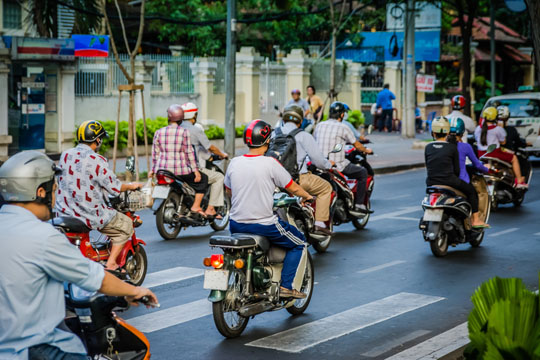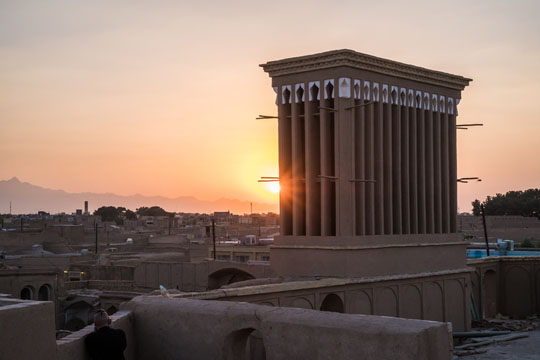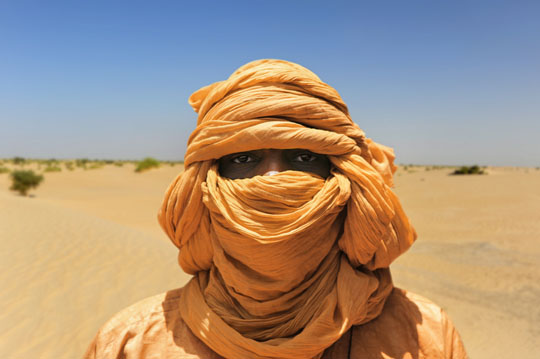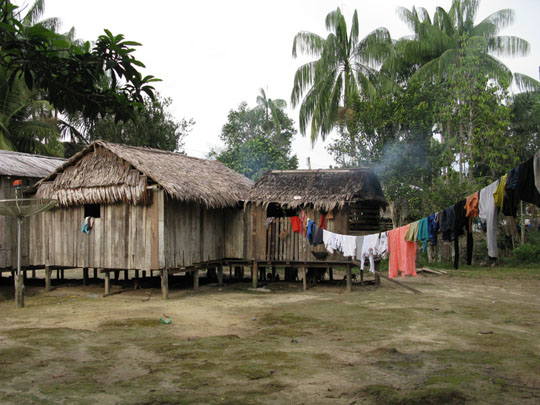The world of warmth
Freiburg, Aug 15, 2017
The ways people deal with sultry weather are many: In Indonesia they ride motorbikes rather than exerting themselves cycling; in Iran, they rely on cooling wind towers when temperatures get high; folks in the central Sahara shelter in buildings made of clay; and in the Amazon, manioc beer is the thirst quencher of choice. Four University of Freiburg professors take us on a tour of the some of the world's warmer climes.
 Photo: Detailblick-Foto/Fotolia
Photo: Detailblick-Foto/Fotolia
Southeast Asia: Breezing along on motorbikes
Anyone in Indonesia who can afford it buys themselves a motorbike or a motor scooter to stay cool while getting from place to place. The airstream refreshes the riders and you don't work up a sweat like you do on a bicycle, says Prof. Dr. Judith Schlehe of the Department of Ethnology. "In general, people in Indonesia are less likely to be in a rush. They cultivate a leisurely approach to things," she continues. Although temperatures in Southeast Asia are much higher than they are in Germany, Schlehe's Indonesian doctoral candidates complain about the heat in the buildings and at the university. "It's no wonder, when you consider that public buildings in Indonesian cities are almost always air conditioned," explains the ethnologist. What is more, Schlehe's Indonesian students who were taking part in a training research project about clothing and weather discovered to their surprise that the color of Germans' attire changes with the seasons. Schlehe elaborates: Starting in August it became apparent from selections in the shops that the colorful summer collections were being replaced by darker autumn and winter fashions. In countries like Indonesia, where there are dry and rainy seasons, but no seasonal temperature changes, doing this wouldn't occur to anyone, says Schlehe.
 Out and about on a scooter – getting quickly from point A to point B without breaking a sweat.
Out and about on a scooter – getting quickly from point A to point B without breaking a sweat.
Photo: Dihetbo/Fotolia
Central Asia: Natural air conditioning
The summer months are also much hotter in Isfahan – Freiburg's partner city in Iran – than they are in southern Baden. There aren't really seasons as such in Central Asia. The continental climate means it's either dry and hot or dry and cold. "During the summer months it's particularly important for the region's residents to protect their bodies from high levels of solar radiation by wearing long, airy clothing," explains Prof. Dr. Tim Epkenhans of the Oriental Seminar. The locals have also developed architectural technologies to help them take the heat. "The wind towers that are atop buildings work like natural air conditioners," says Epkenhans. The structures come from traditional Persian architecture. They catch breezes that reduce room temperatures on hot days, while on cool nights, they raise them. Clay walls contribute as well to moderating the heat inside.
 Wind towers are special architectural features that help to ventilate buildings.
Wind towers are special architectural features that help to ventilate buildings.
Photo: Thomas Leonhardy/Fotolia
Central Sahara: Headdresses hold down the heat
Clay is a primary building material in African countries. Homes and mosques are made of it. "They only have a few windows, and these open mainly onto courtyards," says Prof. Dr. Rüdiger Glaser of the Institute of Physical Geography of the buildings. When he crossed the Central Sahara on an expedition in the 1980s, he was above all struck by the high value placed on water, a precious commodity. "We had to drink five liters daily and were often asked to share our water with travelers we encountered," he recounts. After drinking plenty of water, covering the body completely to shield it from the sun was the next priority. "We soon changed our shorts for clothing that covered us. In the end, some of us were even wrapping up our heads, as we saw the native Tuaregs do," says Glaser. Despite the protective garments, the locals also avoid the noonday heat, using the night and early morning hours to go about their business," he explains. Nighttime temperatures in the Sahara drop down to 20 to 25 degrees Celsius. "That seemed quite cool to us, so we wore pullovers," remembers Glaser. "There was nothing surprising about children even wearing turtle neck sweaters in the mornings," he adds.
 Tuaregs native to the Central Sahara wrap up their heads to protect themselves from the sun, sand and wind.
Tuaregs native to the Central Sahara wrap up their heads to protect themselves from the sun, sand and wind.
Photo: Quickshooting/Fotolia
The Amazon: Manioc beer refreshes
People in the Amazon also make the night into day to deal with the heat. Prof. Dr. Anna Meiser of the Department of Ethnology says, "The day starts at 4 a.m. As long as it's still dark, it's time for breakfast and talking about plans for the day. The workday starts when the sun comes up." Afternoons are time for siestas, and after work, people meet their family and friends to cool off at the river. Meiser sums up, "The daily routine is adapted to the weather." Due to its tropical climate, the Amazon has a consistently warm average temperature without extreme heat waves. Architecture suited to the climate can be found, for example, in the traditional villages in the rain forest. Huts at heights of up to eight meters above the ground are surrounded with a palisade fence and a canopy made of leaves. "Air circulation and temperature regulation work very well in these structures," says the ethnologist. And unlike in Germany, people in the Amazon region rarely drink pure water to quench their thirst. Instead they prefer tea and banana brew. Filling manioc beer, which contains protein, is another favorite beverage.
 Traditional structures in the Amazon rain forest have good air circulation and regulate temperature well.
Traditional structures in the Amazon rain forest have good air circulation and regulate temperature well.
Photo: Guentermanaus/Fotolia
Emilie Häberle

